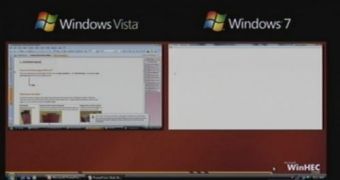Microsoft already proved that on the same system configuration Windows 7 would boot a few seconds faster than Windows Vista. But fact is that the evolution from Vista to Windows 7 is not limited to the boosted startup times. In this context, at the Windows hardware Engineering Conference in Los Angeles, Mike Angiulo, General Manager, Windows Planning and PC Ecosystem Team for Microsoft, and Jon DeVaan, Senior Vice President of the Core Operating System Division, revealed Windows 7's superiority compared to Vista also in terms of memory usage and graphics performance.
“Once we're even booted we've done a lot to improve the memory usage, and the graphics performance. This graph that you see on the screen here shows how in Vista we scale linearly with the number of open windows, so that's the amount of memory that's consumed by the system as you open more Windows. In Windows 7 we used a small fixed set of memory that doesn't grow as we open more Windows,” Angiulo stated before launching what he referred to as a torture test script designed to open in excess of 70 different windows on two identical machines running Vista and Windows 7.
The result? Windows Vista simply could not take it. This is of course nothing new to long time Vista users who had to deal with the operating system hitting speed bumps in terms of memory handling and graphics performance. Service Pack 1 indeed improved the general experience of the operating system, but what Microsoft demonstrated at WinHec 2008 is more than Vista is capable of, SP1 or no SP1.
When Angiulo run the script on Vista “at about 25 percent you sometimes see a warning that your computer is running slow, and then you get at 30 percent a message that you've lost Aero. So we've reverted to Windows basic, we've lost the glass effect, and we've done everything we can if the system is running out of memory. On Windows 7, a machine with an identical hardware box, (...) the same script results in no errors, it launches faster, and we actually still consume less memory on the system,” Angiulo explained.
Microsoft has done away with double buffering in Vista, and this is the reason why Windows 7 will actually deliver a superior performance on Windows 7. “It's basically because we're letting the video card do its job in managing the memory for those windows,” DeVaan stated, with Anguilo adding, “even though we're using less memory we actually have a faster graphics system going on Win 7”.

 14 DAY TRIAL //
14 DAY TRIAL //